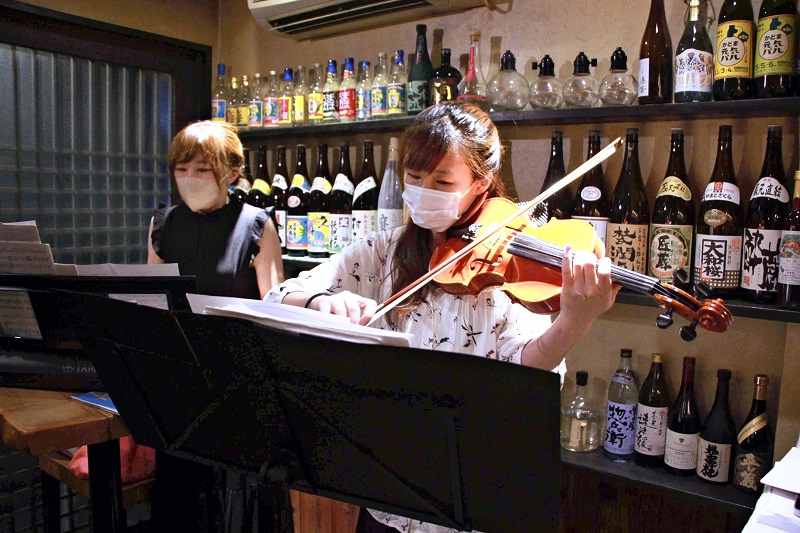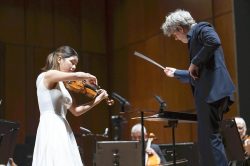
Kansai Philharmonic Orchestra violinist Matsuno Noguchi performs at Torimaru, a yakitori restaurant in Kadoma, Osaka Prefecture, on May 23.
5:57 JST, June 17, 2022
After the cooked chicken skewers are taken off the grill, the announcement is made that the show is about to start and that ordering for yakitori will be temporarily halted.
A hush falls over normally bustling Torimaru, a yakitori grilled chicken restaurant in Kadoma, Osaka Prefecture. It is an evening in late May, and Matsuno Noguchi of the Kansai Philharmonic Orchestra starts playing her violin to the accompaniment of a piano.
Local orchestras were among the many businesses hit hard by the pandemic, which forced the cancellation of live performances and dried up funding. Getting back on their feet has proved difficult, and some are getting creative in finding new “stages” to perform or rebuilding a fan base.
Whether it is performing at an izakaya pub or coming up with an annual pass for unlimited performances, the driving force has been the passion to never “let the music die.”
At Torimaru, Noguchi, 34, starts out with an elegant version of Bach’s “Air on the G String,” only to follow it up with the up-beat theme song from the old detective drama “Taiyo ni Hoero.”
As smoke from the grilling chicken could affect the sound from the instruments, the shop stops taking orders during the performance. Customers are not bothered, and clap in time with the rhythm.
The Kansai Philharmonic is the leading orchestra in the Kansai region, but was hit by a series of cancellations and postponements of concerts during the pandemic. That resulted in the group being unable to pay rent on practice space in Osaka City and moving its base in March last year to the Osaka suburb of Kadoma City.
“We can’t survive unless we make fans in Kadoma,” one member said.
Feeling a sense of crisis, the group set up a fan club for local residents and launched a number of unique perks, such allowing fans to watch rehearsals in a bid to spread the word about the orchestra. Noguchi’s “izakaya concert” was well received, and several customers later went to the performance hall.
“It closed the distance with the customers,” Noguchi said. “I want to convey more of the charm of classical music.”
Staying alive
The Tokyo Kosei Wind Orchestra (TKWO), Japan’s preeminent professional wind instrument band, reemerged in April as a general incorporated association following its split from the Rissho Koseikai, a lay Buddhist body that had managed and funded the group.
During its history of over 60 years, the orchestra could not operate on concert income alone and received several hundred million yen a year from the religious organization. The pandemic made the financial situation worse, and in November 2020, Rissho Koseikai issued the orchestra a notice to disband.
The TKWO members decided to pursue a path of operating independently. Rissho Koseikai has continued to provide a practice room and financial aid for the time being, but it is less than a third of what it used to provide. The TKWO set up a patronage system to solicit individual and corporate sponsors. “We’ll do whatever we can,” TKWO chairman Motohisa Katsukawa said.
The Pacific Philharmonia Tokyo, also facing hard times, started issuing from last year an annual passport for students aged 25 or younger. For ¥5,000, the students can attend as many concerts as they want, which aims for the double effect of making use of vacant seats and introducing young people to classical music.
It expanded the scope of eligible concerts to those performed by affiliated orchestras, and succeeded in tripling the number of purchasers from last year.
“If it means attracting future fans, we are prepared to continue this program at a loss,” a Pacific Philharmonia Tokyo official said.
According to the Association of Japanese Symphony Orchestras (AJSO), which comprises 38 professional orchestras nationwide, a total of 1,952 concerts were either postponed or canceled when coronavirus infections surged in fiscal 2020.
Although many orchestras survived the crisis through donations from fans and other means, AJSO secretary general Hiroshi Kuwabara said the groups have a long way to go.
“The number of people enjoying live music has decreased due to the pandemic,” Kuwabara said. “To get people to come to concert halls, each orchestra needs to show its individual characteristics and think of ways to distinguish itself.”
"Culture" POPULAR ARTICLE
-

Van Cleef & Arpels Dazzles with Art Deco Artisanry at Tokyo Exhibit
-

Disney’s ‘Twisted-Wonderland’ Animated Series Puts Villains in Spotlight: New Show Features School Inspired by Classic Disney Films
-

Japan Plans to Distribute Manga Overseas Via New Platform
-

Ayumi Hamasaki’s Shanghai Concert Canceled Day Before Schedule as Part of Beijing Backlash
-

‘The World Masterpiece Theater Series’ Celebrates 50 Years; Animator Looks Back on Creating Anime Classics
JN ACCESS RANKING
-

Tokyo Economic Security Forum to Hold Inaugural Meeting Amid Tense Global Environment
-

Keidanren Chairman Yoshinobu Tsutsui Visits Kashiwazaki-Kariwa Nuclear Power Plant; Inspects New Emergency Safety System
-

Imports of Rare Earths from China Facing Delays, May Be Caused by Deterioration of Japan-China Relations
-

University of Tokyo Professor Discusses Japanese Economic Security in Interview Ahead of Forum
-

Japan Pulls out of Vietnam Nuclear Project, Complicating Hanoi’s Power Plans
























